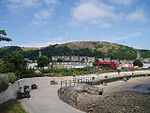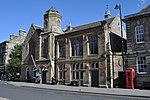RMS Campania
1892 shipsBlue Riband holdersMaritime incidents in 1918Passenger ships of the United KingdomShips built in Govan ... and 3 more
Ships of the Cunard LineSteamships of the United KingdomUse British English from September 2017

Campania was a British ocean liner owned by the Cunard Line, built by Fairfield Shipbuilding and Engineering Company of Govan, Scotland, and launched on Thursday, 8 September 1892. Identical in dimensions and specifications to her sister ship RMS Lucania, Campania was the largest and fastest passenger liner afloat when she entered service in 1893. She crossed the Atlantic in less than six days, and on her second voyage in 1893, she won the prestigious Blue Riband, previously held by the Inman Liner SS City of Paris. The following year, Lucania won the Blue Riband and kept the title until 1898 - Campania being the marginally slower of the two sisters.
Excerpt from the Wikipedia article RMS Campania (License: CC BY-SA 3.0, Authors, Images).RMS Campania
Geographical coordinates (GPS) Address Nearby Places Show on map
Geographical coordinates (GPS)
| Latitude | Longitude |
|---|---|
| N 56.033333333333 ° | E -3.2166666666667 ° |
Address
Tayside Region
PH1 3LW
Scotland, United Kingdom
Open on Google Maps









